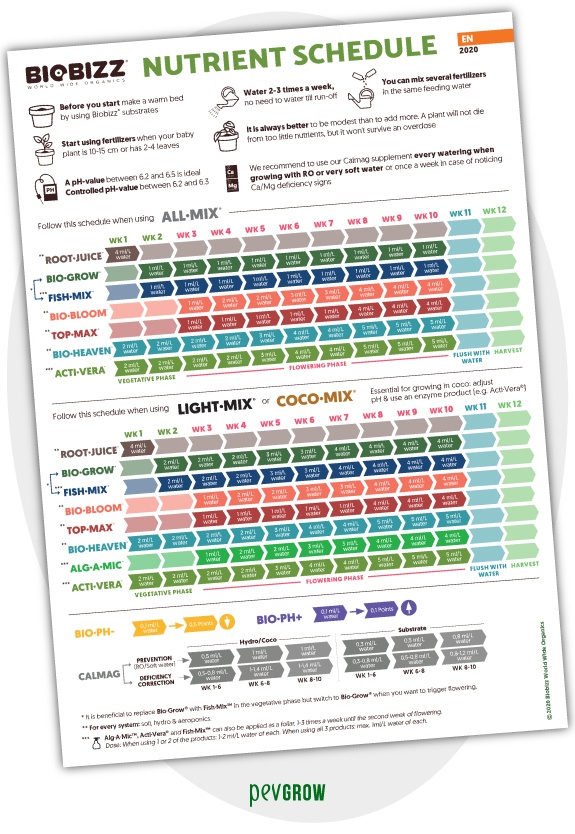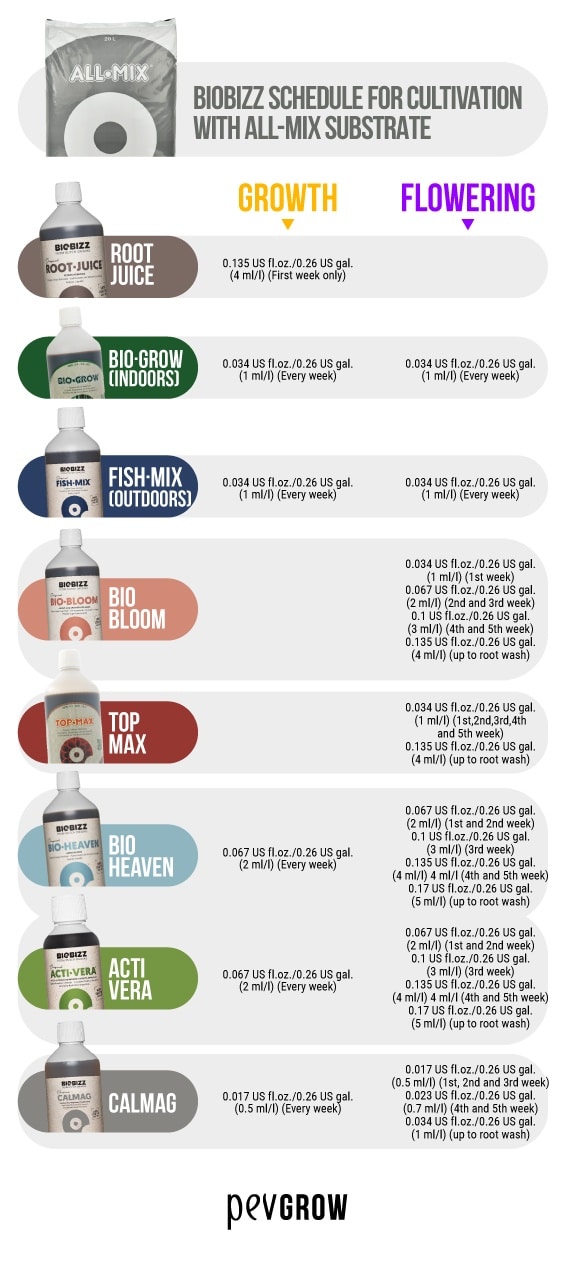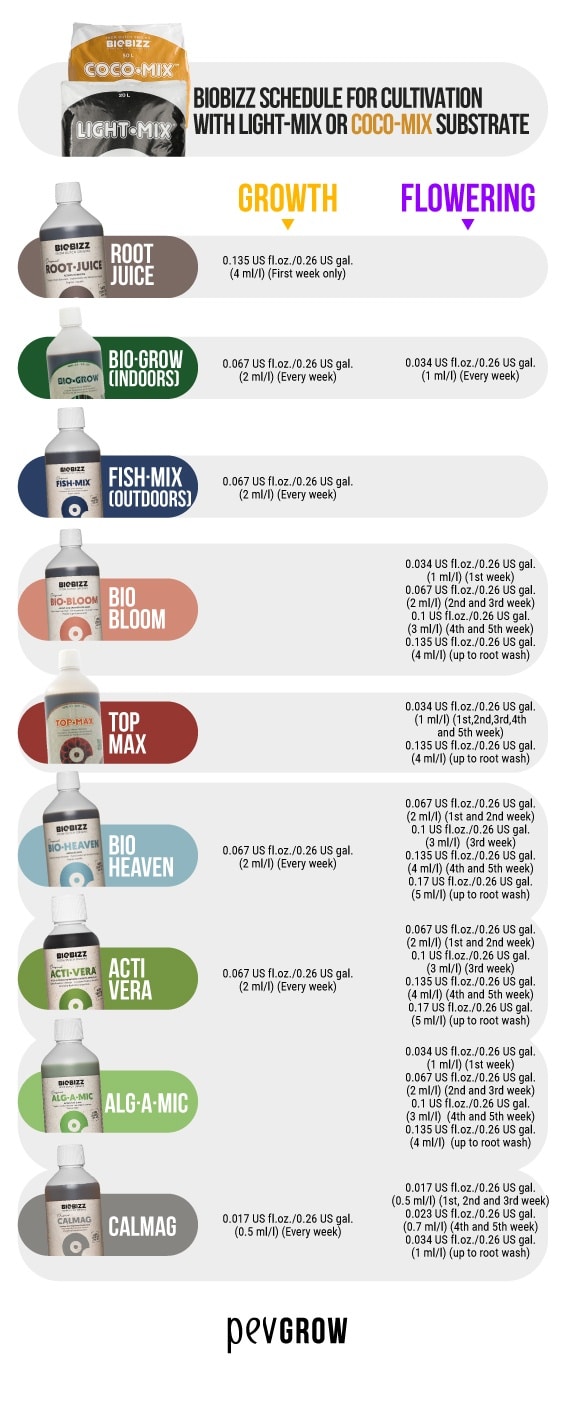

In constant struggle for the regulation of cannabis, mainly in the medicinal field.
07-02-2025 08:00:34 - Updated: 7 February, 2025
What is the dosage of Bio Grow or Fish Mix? How to use Root Juice in autoflowering plants? Many customers want to know how to apply Biobizz’s watering schedule on their crops. Even though they look again and again at the brand’s nutrition chart, they still don’t fully understand how much cannabis fertilizers is needed at each stage.
I remember that this also happened to me at the beginning, we must admit that some of them are difficult to understand, not only the one of this brand, and on top of that many years they change information or add products. For these reasons we have seen fit to write an article that carefully explains how to use Biobizz fertilizers.
First of all, it should be taken into account that this is a guide chart, so the fertilization programme must be adapted to the needs of each crop. Do not worry, as soon as you do it the first time you will see that it is not so complicated.
✨ Biobizz nutrient schedule with reference calendar

The first thing you can see, at the top, is a brief explanation of how to use it, something to be taken into account before starting to use the products, and we are going to extend it a little more to make it clearer:
– This watering schedule is designed to combine Biobizz fertilizers with their specific substrates. What does this mean? Well, that they are formulated to compensate for the necessary nutrients in each phase, but taking into account those that already contain both their soils and the brand’s coconut fiber. So you can’t use Biobizz liquids with other substrate brands? It is possible, but not ideal, because incompatibilities can be created, just as when combining liquid fertilizers of different brands in the same crop.
– Biobizz considers that the first week of cultivation begins when the plants already have 2 or 4 real leaves, apart from the cotyledons. Until that moment the plants do not require more food than water, so we will start counting the first week in the nutrient schedule from there.
– Ideal pH for Biobizz fertilizers ranges from 6.2 to 6.5, rising gradually and starting from the lowest at the beginning of the vegetative growth phase, that is 6.2. During the last week of growth you can go up to 6.3 and at the middle of flowering you can go up a tenth more, up to 6.4. The last 2 or 3 weeks of growing we can reach up to 6.5 pH, and this should be adapted to the different flowering cycles of cannabis varieties, as some need only 7 weeks and others may require more than 12, depending on their genetics.
– Usually we water 2 or 3 times a week, but this depends on many factors and some plants may need more than 3, or even only one watering per week. In any case, our advice is to always split up a watering with fertilizers and another with water, and to wait until the substrate has dried up a little before watering again.
– Biobizz’s liquid fertilizers can be perfectly combined with each other, so you can mix different products in the same irrigation water without any problems. But you have to take into account that the pH is corrected after adding all the products that are necessary in that cultivation phase. This is because many fertilizers cause fluctuations in the pH, so you always have to adjust it at the end.
– It is much easier to correct a lack than an excess of fertilizers, which is why Biobizz recommends that it’s more convenient to fall short than to overdo it. In fact, deficiencies are accentuated after several irrigations, but an excess can be shown in a very short time. The recommended amounts of product in these fertilizer programs are calculated for crops without limiting factors, when the plants can absorb the maximum amount of food because all the parameters are perfect, but this is not always the case with cannabis crops, especially for beginners, so there are plants that may need less quantity.
– Calmag is a product designed to compensate for the lack of Calcium and Magnesium in crops where soft water is used, that is, with very low levels of E.C. Our advice is to use osmosis water with the minimum level of electroconductivity in areas where tap water contains an E.C. greater than 0.5 and always start from 0.0 or 0.1 E.C. so as not to cause blockages, excesses or deficiencies of these elements.
– Biobizz has 2 specific products to adjust pH, BIO-PH – to reduce pH of the nutrient solution and BIO-PH + to increase it. Care must be taken when administering them, because BIO-PH – drops 0.5 points with every 0.034 US fl. oz. (0.1 ml.) of product, and BIO-PH + raises 0.1 points of PH with every 0.034 US fl. oz. (0.1 ml.) of product.
– As you will see, the schedule is a calendar covering 12 weeks of cultivation altogether, where the first 2 are for the vegetative growth cycle, and the remaining 10 for flowering. The last 2 weeks of flowering no fertilizers should be added to the irrigation because during that period the roots must be washed, so you only irrigate with water.
– If you look at the nutrition programme on this chart, you will see that the weeks of the flowering cycle can be distinguished into 4 phases where the amounts of nutrients change significantly from one to the other. The first phase is the pre-bloom phase, which lasts 2 weeks, the next phase is the bloom phase, which is the next 3 weeks, then comes the fattening phase which lasts 3 more weeks, and the last phase would be the ripening, which takes place at the same time as the root washing. As you know, there are marijuana seeds that are harvested weeks earlier than others, so we have to adapt this fertilization schedule to the plants we are growing.
– The measurement unit for these liquid fertilizers is ml/l (millilitre per litre). This means that for every litre of irrigation water the amount of millilitres indicated on the chart at that time must be diluted.
👌 Other factors to take into account before deciding on the dosage of Biobizz fertilizers
- Light output: The higher the light output, the greater the feed requirements, as the plants will be able to process more of it.
- Temperature: The higher the temperature, the greater the transpiration of the plants, and therefore the watering needs, remember that the ideal temperature is about 75º F. (24º C.).
- Humidity: As with temperature, ambient humidity influences the need for water. The ideal humidity for the vegetative growth cycle is between 60% and 70% and in flowering always below 50%.
- Pot size: This aspect is very important and is often neglected. When the plant is very large compared to the size of the pot it obviously needs more watering, and this influences the amount of nutrients it can absorb as well.
- Plant genetics: Not all varieties eat the same, in fact they have absolutely nothing to do with the food needs of a pure Afghani compared to a Haze hybrid.
🚀 How to use Biobizz guide
If you look at the chart you will see that there are 2 complete fertilization schedules, the fist one to use All-Mix soil and the second one to use Light-Mix or Coco soil. The different dosages have to do with the different amounts of nutrients that those types of substrate contain, since All-Mix contains a lot of food, while Light-Mix does not contain so much, and Coco-Mix even less.
The food difference of the different substrates of Biobizz is mainly relative to Nitrogen, if you look at the dosage you will see that the dosage changes in Bio-Grow and Fish-Mix, and also Alga-Mic is not used with All-Mix substrate.
When using All-Mix substrate, check only the first chart and, taking into account what we have seen before, we will detail the schedule product by product:
BIOBIZZ SCHEDULE FOR CULTIVATION WITH ALL-MIX SUBSTRATE
BIOBIZZ SCHEDULE FOR CULTIVATION WITH LIGHT-MIX OR COCO-MIX SUBSTRATE
If you prefer to grow with Light Mix or Coco Mix substrate, forget about the table above and just look at the one below. In this case you will see that there is one more product, Alg A Mic, but don’t worry, it’s very easy and I’m going to detail everything for you down here, too.
✅ Understanding Biobizz Irrigation Graphic
First of all we prepare the bucket or tank with the amount of water needed for the irrigation that we have to do at that moment. I strongly recommend you to use soft water, you don’t know how many growers get frustrated by not getting great results, because of watering with hard water. If you have tap water with an E.C. higher than 0.5 I advise you to use osmosis water, this is very important and many times we do not take it into account. Then we choose the products that the weekly nutritional calendar suggests us according to the growing phase, and we start mixing them one by one with the irrigation water.
🔥 How To Use Biobizz Fertilizers
- Shake vigorously the package so that its contents are mixed as homogeneously as possible, bearing in mind that they are 100% organic, so they are very dense liquids.
- Open the bottle and with the help of a measuring pipette or cup, put the amount of US fluid ounces (millilitres) of the product calculated with the Biobizz watering chart into the bucket or tank with water.
- Stir well the irrigation water so that the fertilizer is diluted and repeat step 2 and this process with all the products we have to add during this growing week.
- Once we have mixed all the liquid fertilizers necessary for irrigation, we proceed to adjust pH. Remember what we talked about before, I don’t want to be a bore, but pH is always measured at the end.
- Now we can water our girls, I guess this step will be clear to you, but I’m still going to share with you an article that explains the best way to water cannabis.
- Store fertilizer bottles in a cool, dark, dry place away from the kids, so they won’t mistake it for smoothies… The nutrient solution we have prepared must be used at once, if you have any left you can use it for other plants, but I advise you not to save it for another day.

🎯 Tips and other guidelines for using Biobizz products
Please note that Biobizz calculating table is intended for cannabis varieties that need about 12 weeks of cultivation altogether, 2 weeks of growing and 10 weeks of flowering. It was done this way because most of today’s commercial hybrids are developed around those times, but some genetics are harvested earlier and others may require a few more weeks, so try to adjust watering schedule to the needs of the strains you are growing, and sometimes give a few more weeks of growth, or even a few less. I will give you a couple of examples to help you understand it better, imagine you are growing a Black Domina or another variety that does not stretch much during flowering, and when you have to change the photoperiod you realize that it barely has 8 inches (20 cms.), so it would be better to give some more weeks of growth, what do we do?
In this case the best option is to leave the plants longer at 18 hours of light per day and let them continue to grow. And what do we feed it? Well, we follow the fertilizer reference data from the last week of the growth cycle for as long as we need, until we notice that our girls have the desired size to move to flowering, just like that.
It is also possible the opposite situation, imagine that you want to grow a pure sativa indoors, and you can not give more than a week of vegetative growth so that they do not become huge. How should you proceed? In this case it is best to follow the nutritional chart referring to the first week of cultivation, so they get the Root Juice root stimulator, then move to 12/12.
Its pre-flowering phase lasts about 1 month, so we would continue with the feeding that the nutrient dosage chart shows for the first 2 weeks of the cycle for that whole month. With this variety, the fattening phase must be extended by at least 1 week, but the ripening and root washing phase can remain the same, at 2 weeks. This same situation can happen with a Neville Haze, a Kali Mist Pre-98 and many other sativa varieties.
For early flowering hybrids you do the opposite, i.e. you adapt the Biobizz chart but reduce the number of weeks in each phase. This often happens with cuttings, as there are incredibly fast selections like Critical Bilbo, which can be harvested in just 50 days of flowering. With this plant in particular what we do is reduce 1 week of each “phase” of this cycle, except for the wash and ripening phase, reducing the total flowering time from 10 weeks (70 days) to 7 weeks (49 days). You will also experience this with the Fast, Early or Quick varieties, which are extremely fast, so it is good to know.
👾 How to adapt Biobizz chart for Autoflowering plants
Considering all these things, applying the nutrition programme in automatic varieties you will understand it very easily. The only thing I would add in this regard is that I like to give Root Juice for 2 or 3 weeks of growing cycle, instead of just one week as we see in the feeding chart.
Autoflowering plants begin to show pre-flowers about 25 days after germination, and it overlaps with the pre-flowering “phase” I was explaining to you earlier, around the second week of flowering that the table points out.
One thing that happens with many automatic flowering strains is that while they are flowering they continue to grow, just like sativas. Ideally, you should follow the data on the graph during the flowering “phase” until you realize that your autoflowering plants have stopped growing.
As soon as they stop growing, we move on to the fattening “phase” and remain so until you see the first stigmas begin to wither, which will be the sign that we must move on to the root washing and ripening phase.
🧐 Understanding Biobizz watering schedule for outdoor crops
Making a weekly outdoor cultivation chart is impossible, as so many factors come into play that the times cannot be determined. That is why it is essential to observe the plants as much as possible to see their needs at all times. In this case there are some Biobizz products that I haven’t told you about until now that can come in very handy.
Pre-Mix is used to improve the soil, especially in crops where we are going to transplant to direct soil. It is a mixture that provides a great amount of quality nutrients, ideal for orchards or gardens. Worm-Humus is an excellent type of earthworm humus, which is used both to improve the substrate and to use as a mulch to enrich the medium through leaching. And Leaf-Coat is suitable for both indoor and outdoor cultivation, it is a preventive insecticide and fungicide, which also provides nutrients, and is used in a sprayed form. Indoors if you are careful you are less likely to get visits from pests, but outdoors I encourage you to use it, it can save your harvest.
Outdoors we already know that the growth period of the plants extends much more than the 2 weeks we give indoors, so we’ll continue with the amounts of nutrients it says on the table for this phase until pre-flowers appear.
Once the first hairs come out we will start counting as a pre-flowering phase, which will also take longer than in indoor cultivation. We continue to water with what corresponds to this period until we notice that the first buds are beginning to form, which will give way to the flowering “phase” that we saw earlier.
We will continue with this phase until we see that the buds begin to take density, when they’re no longer just a bunch of hairs. From this moment the fattening phase begins, which lasts until we see the stigmas that cover the buds start to get dark or shrivelled. From this moment on we stop adding fertilizers to the watering and wait for the plants to fully mature.
⚠️ Doubts, other issues and conclusions
Don’t go crazy, Biobizz feeding chart is a guide to help us nourish cannabis plants in the best possible way in each of their phases. It’s good to keep it in mind, personally I have obtained great results both in quality and quantity by following it carefully, but I also tell you that with some genetics we have to adapt it to be able to squeeze the maximum performance out of it. The best thing is what I told you before, to observe the general state of the plants and in case of detecting possible deficiencies or excesses act as fast as possible to correct them.
We hope that we have solved your doubts about using Biobizz fertilizers and the meaning of their weekly feeding schedule, and if you share this post you will also get the best resinous buds of your life.
👾 FAQ
When to apply Fish Mix and when to apply Bio Grow?
Fish Mix is used only during the growth phase and especially in outdoor crops, due among other things to its intense fish aroma, which leaves the growing space you don’t even want to come in. It is used as a substitute for Bio Grow, never together as both contain a lot of Nitrogen and Potassium. Bio Grow, on the other hand, can be used throughout the entire growing period, both in growth and flowering, indoors and outdoors. It contains slightly less Nitrogen than Fish Mix, but more Phosphorus and Potassium.
Question: How to use Alg A Mic correctly?
This product is only used with Light Mix substrate, coconut or low-nutrient soil. It is added only during the flowering phase and the dose increases from 0.034 US fl.oz./0.26 US gal. (1 ml/l) to 0.135 US fl.oz./0.26 US gal. (4 ml/l). Alg A Mic is a revitalizer that can be used in a foliar way, but once there are flowers it is better to use it in irrigation.
Question: When is the best time to apply Root Juice?
Although the brand recommends using this product for the first week of growth and no more, Root Juice goes great after every transplant too. With autoflowering we use it the first 2 or 3 weeks of life, and in outdoor cultivation if we germinate very early we use it during the first month and later after each transplant.
How Often to Fertilize with Biobizz?
Biobizz Fertilization Frequency:
The frequency with which you should fertilize your plants with Biobizz products depends on the growth stage of your plants and the type of cultivation you are performing. Here I provide a general guide based on the manufacturer’s recommendations:
*Germination and Seedling:
- Biobizz Root-Juice: Use once at the beginning to stimulate root development.
- Biobizz Bio-Heaven: Apply once a week to improve nutrient absorption.
*Vegetative Stage:
- Biobizz Bio-Grow: Fertilize 2-3 times per week to encourage vigorous growth. You can start with lower doses and gradually increase.
- Biobizz Alg-A-Mic: Use once a week as a supplement to improve the overall health of the plants.
*Pre-Flowering Stage:
- Biobizz Bio-Grow: Continue with 2-3 times per week.
- Biobizz Bio-Bloom: Introduce and apply 2-3 times per week.
- Biobizz Top-Max: Apply 2-3 times per week to increase flower and resin production.
*Flowering Stage:
- Biobizz Bio-Bloom: Continue applying 2-3 times per week.
- Biobizz Top-Max: Continue applying 2-3 times per week.
- Biobizz Bio-Heaven: Use 1-2 times per week to optimize nutrient availability.
*Maturation Stage:
- Biobizz Bio-Bloom: Gradually reduce the frequency in the last weeks before harvest.
- Biobizz Top-Max: Continue applying until one week before harvest.
*Additional Tips:
- Check the Fertilization Chart: Biobizz provides a specific fertilization chart for its products, which details the exact doses and frequency of application for each growth stage. Make sure to consult it regularly.
- Monitor the Plants: Closely observe your plants to adjust the doses and frequency according to their specific needs. Factors such as soil type, light, and plant strain can influence nutrient needs.
- Water with Adjusted pH: Always use water with the appropriate pH (between 6.2 and 7.0) to maximize nutrient absorption.
Remember that it is better to start with lower doses and gradually increase based on your plants’ response. Over-fertilization can be as harmful as a lack of nutrients.
Is Biobizz Organic?
Yes, Biobizz is a brand of organic fertilizers. Biobizz’s philosophy focuses on offering cultivation products that are completely organic and environmentally friendly. Here are some reasons and features that confirm the organic nature of Biobizz:
Natural Ingredients:
- Composition: Biobizz products are made from natural and renewable ingredients, without using synthetic chemicals or artificial pesticides.
- Certifications: Biobizz has several certifications that endorse its commitment to organic agriculture, such as the OMRI (Organic Materials Review Institute) certificate and the Control Union Certifications seal, which guarantee that their products meet international organic production standards.
Specific Products:
- Bio-Grow: A liquid fertilizer based on sugar beet extracts and other natural ingredients, designed to promote healthy growth during the vegetative phase.
- Bio-Bloom: A liquid fertilizer formulated for the flowering stage, made from algae, bone meals, and other natural elements that provide the necessary nutrients for abundant and healthy flowering.
- Alg-A-Mic: A wellness supplement that uses organic seaweed to provide a natural boost of vitality and resistance to plants.
Sustainability:
- Environmental Impact: Biobizz strives to minimize its environmental impact, using sustainable production processes and recyclable packaging.
- Soil Health: Biobizz products help improve the structure and health of the soil, promoting a more balanced and sustainable cultivation ecosystem.
Benefits for Plants:
- Nutrient Absorption: Being organic, the nutrients in Biobizz fertilizers are in forms that plants can easily absorb, promoting healthier and more natural growth.
- Better Taste and Quality: Using organic fertilizers like those from Biobizz can improve the taste, aroma, and overall quality of the crops, as they do not introduce chemical residues that may alter the natural characteristics of the plants.
How Much Bio Grow from Biobizz to Use?
The correct use of Bio Grow from Biobizz depends on the growth phase of your plants and the medium in which you are cultivating. Here is a detailed guide so you can make the most of this organic fertilizer:
General Dosage of Bio Grow:
- Growth Phase: During the vegetative phase, it is recommended to use between 1 ml and 4 ml per liter of water, gradually increasing the dose as the plants grow.
- Flowering Phase: Although Bio Grow is mainly formulated for the vegetative phase, it can also be used in the flowering phase in combination with Bio Bloom to ensure that the plants receive a full spectrum of nutrients, in this case only 1 ml/l.
Medium of Cultivation:
- Soil: Bio Grow is particularly effective in organic soils rich in nutrients. The dosage can be slightly adjusted according to the richness of the soil.
- Coco and Other Inert Substrates: If you are using inert substrates like coco, it is important to complement Bio Grow with other essential nutrients that may be lacking in these media.
Frequency of Use:
- Regular Watering: It is recommended to use Bio Grow in each watering during the growth and flowering phases.
- Monitoring: It is crucial to monitor the health of the plants and adjust the dose if you observe signs of over-fertilization, such as yellow leaves or burnt tips.
Additional Tips:
- Shaking: Always shake the nutrient solution well before applying to ensure an even distribution of nutrients.
- pH: Although Bio Grow is organic and tends to stabilize the pH, it is always good practice to check the pH of the nutrient solution to ensure it is in the appropriate range (between 6.0 and 7.0 for soils).
Example of a Feeding Plan:
- Weeks 1-2: 1 ml/L, watering every two days.
- Weeks 3-4: 2-3 ml/L, adjusting according to growth and plant response.
- Week 5 onwards: 3-4 ml/L, in combination with other nutrients as needed.
Note: Always follow the specific recommendations of the manufacturer and adjust according to the particular conditions of your cultivation. Observe your plants and adjust the dose according to their response and needs.
How to Use the Biobizz Try Pack: Complete Guide
Biobizz Try Pack is an excellent option for growers who want to experiment with the line of organic fertilizers from Biobizz. This pack includes three essential products: Bio Grow, Bio Bloom, and Top Max. Here I explain how to use them correctly to maximize the growth and flowering of your plants.
Contents of the Biobizz Try Pack:
- Bio Grow (250 ml): Liquid fertilizer for the vegetative phase.
- Bio Bloom (250 ml): Nutrient for the flowering phase.
- Top Max (250 ml): Flowering stimulator.
Usage Instructions:
Growth Phase:
Bio Grow:
- Beginning of Vegetation: Use 1 ml/L of water.
- Advancement of Vegetation: Gradually increase to 2-4 ml/L.
- Watering: Apply it in each watering during the vegetative phase.
Flowering Phase:
Bio Bloom:
- Beginning of Flowering: Start with 1-2 ml/L of water.
- Peak of Flowering: Increase to 3-4 ml/L.
- Watering: Use in each watering throughout the flowering phase.
Top Max:
- Beginning of Flowering: Use 1 ml/L of water.
- Peak of Flowering: Increase to 3-4 ml/L.
- Watering: Apply in each watering during the flowering phase to maximize resin production and the size of the buds.
Example of a Feeding Table:
| Week | Bio Grow (ml/L) | Bio Bloom (ml/L) | Top Max (ml/L) |
|---|---|---|---|
| 1 | 1 | 0 | 0 |
| 2 | 2 | 0 | 0 |
| 3 | 3 | 0 | 0 |
| 4 | 4 | 0 | 0 |
| 5 | 4 | 1 | 1 |
| 6 | 3 | 2 | 1 |
| 7 | 2 | 2 | 1 |
| 8 | 1 | 3 | 1 |
| 9 | 0 | 3 | 1 |
*In the following weeks of flowering, add 1 ml/l of Bio Grow, 4 ml/l of Bio Bloom, and 4 ml/l of Top Max until the root washing of the plants.
Additional Tips:
- Shaking: Always shake the products well before mixing them with water.
- pH of Water: Although Biobizz is designed to work well with the natural pH of water, it is advisable to check that the pH of the solution is between 6.0 and 7.0 for best results.
- Humidity and Ventilation: Maintain good control of humidity and adequate ventilation to avoid problems with mold and other pathogens.
Frequency of Use:
- Regular Watering: Apply the fertilizers in each watering, adjusting according to the specific needs of your plants and the type of substrate you use.
- Monitoring: Regularly observe your plants to detect any signs of over-fertilization or deficiency and adjust the dose accordingly.
Can We Mix Biobizz Fertilizers?
Mixing fertilizers from different brands is a practice that, although possible, is not recommended due to several factors that can negatively affect the development of your plants. Here we explain why it is better to use a single range of fertilizer products, like those from Biobizz, in your cannabis cultivation.
Problems When Mixing Fertilizers from Different Brands
- Nutrient Lockouts: Each brand of fertilizers formulates its products to work in synergy within its own line. By mixing products from different brands, you can create an imbalance in nutrient availability. This imbalance can lead to nutrient lockouts, where certain essential elements become inaccessible to the plants.
- Over-fertilization: The different concentrations and formulas of nutrients can cause over-fertilization, especially if the products are not designed to complement each other. This can result in burns on the roots and leaves, reducing the yield and overall health of the plants.
- Unknown Interactions: The specific formulations and interactions between nutrients and additives can vary significantly between brands. These unknown interactions can result in unforeseen negative effects on soil pH or plant health.







